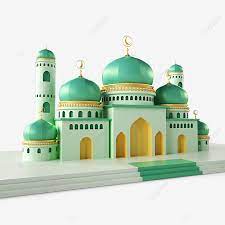Courtesy : en.wikipedia.org
Green islamic architecture
The color green (Arabic: أخضر, romanized: ‘akhḍar) has a number of traditional associations in Islam. In the Quran, it is associated with paradise. In the 12th century, green was chosen as dynastic color by the (Shiite) Fatimids, in contrast to the black used by the (Sunnite) Abbasids. After the Fatimid dynastic color, green remains particularly popular in Shi’ite iconography, but it is also widely used in by Sunni states, notably in the flag of Saudi Arabia and the flag of Pakistan.
There is also an Islamic green color which has the hex
Quran
17th-century Mughal painting of al Khidr
Reclining on green Cushions and rich Carpets of beauty
Upon them will be green garments of fine silk and heavy brocade, and they will be adorned with bracelets of silver; and their Lord will give to them to drink of a Water Pure and Holy.
— Sura 76, verse 21.
Al-Khidr (“The Green One”) is a Qur’anic figure who met and traveled with Moses.
The Green Dome, traditional site of the tomb of Muhammad, was painted green on the order of Sultan Abdul Hamid II (r. 1876–1909).
Islamic flags
Main article: Islamic flags
Main article: List of countries with the Islamic symbols displayed on their flag
Green was used as the color of the banners of the historical Fatimid Caliphate. The Fatimid banner was in use until 1171, and thus during the first century of the crusades,and by this way has taken influence on Christian heraldry, where the tincture vert was very rarely if ever used for the field (background) until the end of the Middle Ages (indeed the term sinople used to signify a reddish color until the 14th century, and only after c. 1400 did it change its meaning to refer to green as a heraldic tincture).
Today, green is also used in several national flags as a symbol of Islam. These include: Algeria, Azerbaijan, Comoros, Iran, Mauritania, Pakistan, Saudi Arabia. and Sri Lanka.ir aq Some Arab countries also use pan-Arab colors which feature green as its component to represent the aforementioned Fatimid Caliphate, though not to Islam directly. These include: Iraq, Jordan, Kuwait, Lebanon, Sudan, Syria, and the United Arab Emirates, as well as several contested states including Palestine, Somaliland, and Western Sahara. Libya formerly also followed this principle, featuring green as its only component color to imitate the Fatimid Caliphate’s flag (at the time the only flag in the world to use only one color) until 2011.
There are also several flags of Muslim-majority countries featuring green color that does not symbolize Islam. Examples include Bangladesh, Tajikistan, Turkmenistan, Uzbekistan, Guinea, Guinea-Bissau, Mali, and Senegal (in the latter four cases, the green color is a component of the pan-African colors, which are also adopted by even Christian-majority countries such as Malawi and South Sudan).




